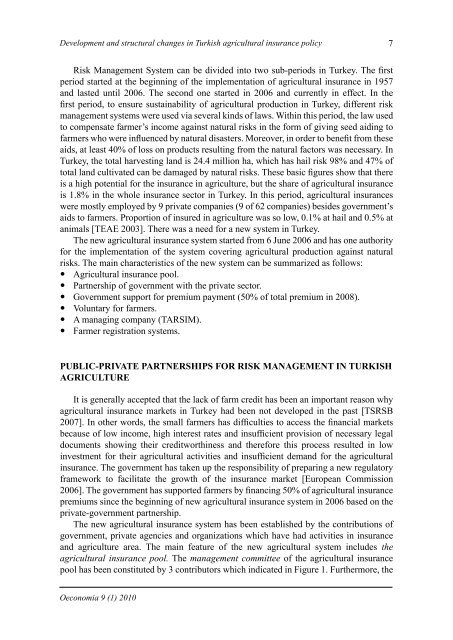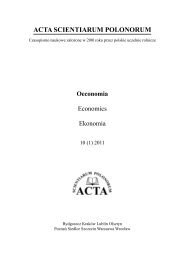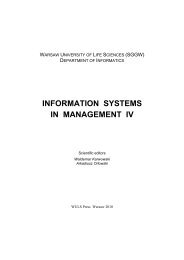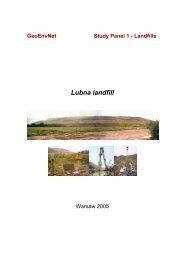Acta Scientiarum Oeconomia 9 (1)
Acta Scientiarum Oeconomia 9 (1)
Acta Scientiarum Oeconomia 9 (1)
You also want an ePaper? Increase the reach of your titles
YUMPU automatically turns print PDFs into web optimized ePapers that Google loves.
Development and structural changes in Turkish agricultural insurance policy<br />
7<br />
Risk Management System can be divided into two sub-periods in Turkey. The first<br />
period started at the beginning of the implementation of agricultural insurance in 1957<br />
and lasted until 2006. The second one started in 2006 and currently in effect. In the<br />
first period, to ensure sustainability of agricultural production in Turkey, different risk<br />
management systems were used via several kinds of laws. Within this period, the law used<br />
to compensate farmer’s income against natural risks in the form of giving seed aiding to<br />
farmers who were influenced by natural disasters. Moreover, in order to benefit from these<br />
aids, at least 40% of loss on products resulting from the natural factors was necessary. In<br />
Turkey, the total harvesting land is 24.4 million ha, which has hail risk 98% and 47% of<br />
total land cultivated can be damaged by natural risks. These basic figures show that there<br />
is a high potential for the insurance in agriculture, but the share of agricultural insurance<br />
is 1.8% in the whole insurance sector in Turkey. In this period, agricultural insurances<br />
were mostly employed by 9 private companies (9 of 62 companies) besides government’s<br />
aids to farmers. Proportion of insured in agriculture was so low, 0.1% at hail and 0.5% at<br />
animals [TEAE 2003]. There was a need for a new system in Turkey.<br />
The new agricultural insurance system started from 6 June 2006 and has one authority<br />
for the implementation of the system covering agricultural production against natural<br />
risks. The main characteristics of the new system can be summarized as follows:<br />
• Agricultural insurance pool.<br />
• Partnership of government with the private sector.<br />
• Government support for premium payment (50% of total premium in 2008).<br />
• Voluntary for farmers.<br />
• A managing company (TARSIM).<br />
• Farmer registration systems.<br />
PUBLIC-PRIVATE PARTNERSHIPS FOR RISK MANAGEMENT IN TURKISH<br />
AGRICULTURE<br />
It is generally accepted that the lack of farm credit has been an important reason why<br />
agricultural insurance markets in Turkey had been not developed in the past [TSRSB<br />
2007]. In other words, the small farmers has difficulties to access the financial markets<br />
because of low income, high interest rates and insufficient provision of necessary legal<br />
documents showing their creditworthiness and therefore this process resulted in low<br />
investment for their agricultural activities and insufficient demand for the agricultural<br />
insurance. The government has taken up the responsibility of preparing a new regulatory<br />
framework to facilitate the growth of the insurance market [European Commission<br />
2006]. The government has supported farmers by financing 50% of agricultural insurance<br />
premiums since the beginning of new agricultural insurance system in 2006 based on the<br />
private-government partnership.<br />
The new agricultural insurance system has been established by the contributions of<br />
government, private agencies and organizations which have had activities in insurance<br />
and agriculture area. The main feature of the new agricultural system includes the<br />
agricultural insurance pool. The management committee of the agricultural insurance<br />
pool has been constituted by 3 contributors which indicated in Figure 1. Furthermore, the<br />
<strong>Oeconomia</strong> 9 (1) 2010

















